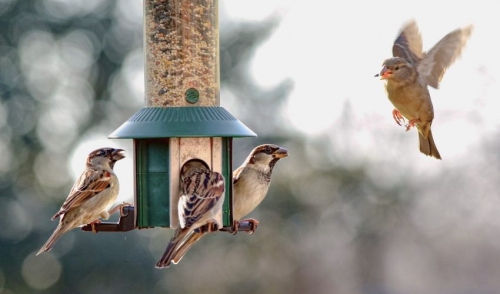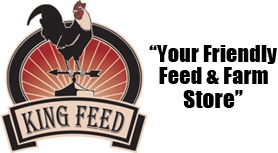{article.name}
Creating a Wild Bird Sanctuary in Your Backyard

- Share this:
- Share on Facebook
- Pin on Pinterest
- Tweet on Twitter
No matter what size your yard, what type of climate you have, or what your level of gardening or landscaping experience, you can create a wild bird sanctuary in your backyard. You only need to meet birds’ basic needs – food, water, and shelter – and you will be amazed at how many enjoy your hospitality.
What Birds Can You Expect?
Before you start landscaping for birds, it is helpful to know what birds to expect. Even the most bird-friendly backyard in California, for example, will never attract birds only found in the eastern United States, such as the northern cardinal or blue jay. Similarly, eastern yards will never be home to western birds like the Cassin’s finch or lazuli bunting. Northern yards won’t see southern specialties like the white ibis, nor will southern yards ever host northern species like the bohemian waxwing.
To learn which birds to design your sanctuary for, consider getting a local or regional bird field guide, or consult local birding groups for tips about common species. Watch for birds in your neighborhood and local parks, or visit a nearby nature center or wildlife sanctuary to see what birds could more easily visit your yard. The more you know about your local birds, the more effective your backyard sanctuary will be for meeting their needs.
Food for Backyard Birds
Food is the best way to provide for birds in your yard. Native plants that provide natural food will be most familiar to birds, as well as most budget-friendly as they thrive in your yard and produce more food each season. Many food-bearing plants will also double as shelter, making your yard even more attractive.
Birds eat a wide variety of foods, and it is easy to provide each one in your yard. The more diverse your bird feeding buffet, the more bird species you can attract
- Seeds – Many birds eat seeds. Sunflowers are a popular and easy option, or you can plant other seed-bearing flowers such as zinnias, daisies, coneflowers, and black-eyed susans. Allow the flowers to mature and go to seed to produce the most food, and sparrows, finches, quail, and doves will happily feast on the bounty.
- Nectar – Different birds sip flower nectar. While hummingbirds are the most popular nectar-loving birds, orioles and finches will also sip from nectar flowers. Adding flowers such as salvia, bee balm, bleeding hearts, columbine, lupine, and trumpet creeper to your yard will provide a rich fountain of nectar for birds to enjoy.
- Fruit – A wide range of birds eat fruit, especially in fall and winter. Adding berry bushes such as raspberries, holly, juniper, and dogwood to your yard will be a great food source. Fruit trees are also a fantastic option, including cherries, apples, crabapples, peaches, and other fruits. Thrashers, thrushes, catbirds, and waxwings will all visit fruitful yards.
- Nuts – Nuts are a hardy fall and winter food source for year-round birds such as jays, nuthatches, and woodpeckers. Providing nut-producing trees and bushes such as hazelnuts, oaks, walnuts, and pines will give these birds a great source of food they can access even when other foods may be scarce.
- Insects – Most birds eat insects, particularly during the spring and summer when hungry hatchlings need protein for proper growth. From gnats and ants to beetles, grubs, spiders, moths, aphids, and more, birds will eat all types of insects and provide valuable pest control in the yard and garden. Minimize or eliminate insecticide and pesticide use to ensure there is plenty of food to go around.
You can always provide supplemental bird feeders in addition to natural foods, and even more birds will gratefully visit your yard. Choose good quality, sturdy feeders in different sizes and designs to appeal to more bird species, and keep the feeders clean and full so they will serve as a reliable, healthy food source whenever birds need a quick snack or convenient meal.
Providing Water for Birds
Birds need fresh, clean water for drinking, bathing, and preening, and there are several ways you can provide water to attract more birds to a backyard sanctuary. Simple basins or dishes can be placed on the ground or mounted on pedestals of different heights, or you can provide more elaborate fountains or moving water features such as shallow creeks or low waterfalls for birds to visit. Shallow ponds are another option, though be sure there are places just 1-2 inches deep where birds will feel comfortable bathing. Deeper ponds with naturalized edges may even attract ducks, herons, or egrets.
Adding more motion to even simple bird baths with drippers, misters, or bubblers will provide splashes and sparkles to attract birds’ attention. Finally, heated bird baths are a necessity in colder regions, when other water sources will freeze up in winter.
No matter which bird baths or water sources you have, keep them filled and clean them regularly so birds are not at risk from dangerous fungus, fecal contamination, or bacterial growth that could cause illnesses. Do not, however, use chemicals or additives to purify water, as these products are not safe for birds to consume.
Sheltering Backyard Birds
All birds need shelter to sleep safely at night, stay protected from predators, or seek refuge from poor weather. There are a number of ways you can add shelter to your backyard sanctuary, including…
- Thickets – Dense shrubbery and layers of plantings will provide natural shelter for birds. Plant layers of different heights and minimize pruning to keep a more natural appearance where birds will feel welcome and secure. Thorny plants are especially effective at deterring predators.
- Hollow Trees – Also called snags, hollow trees are ideal shelter for woodpeckers, owls, and many cavity-nesting birds. Be sure the tree is safe and not threatening to any structures, and consider anchoring it if necessary to preserve the trunk.
- Brush Piles – Adding a brush pile to your yard can provide instant shelter for birds, and is a great way to dispose of an old Christmas tree, pruned branches, or trees that needed to be cut down. Position the shelter in a quiet corner where birds can feel even more secure.
- Birdhouses – Specialized houses and roosting boxes can give birds even more shelter, and can be left up year-round to provide winter shelter as well. Choose houses with good ventilation and drainage, and clean them regularly so there are no pests, mites, or bacteria that can harm birds.
Ideally, provide several types of shelter in your yard, as different birds will prefer different options depending on their needs and the current conditions. With more shelter available, more birds will stay nearby, making use of all the resources you provide. Furthermore, nesting birds may take advantage of the shelter, bringing different bird families to your sanctuary.
More Tips for Your Backyard Wild Bird Sanctuary
Be patient when trying to attract wild birds. The friendlier you make your property, the more likely it is that birds will use it, but it could take some time before many different species feel comfortable in your yard. Start small with your bird-friendly landscaping, and take advantage of local resources such as garden centers, landscaping classes, and local birding groups to learn just what will work best in your yard to attract the most birds. Eventually, you will have your own stunning sanctuary that both you and the birds will enjoy year-round.
Special Offers
We are constantly adding new specials to our site. Be sure to check back often!



Comments